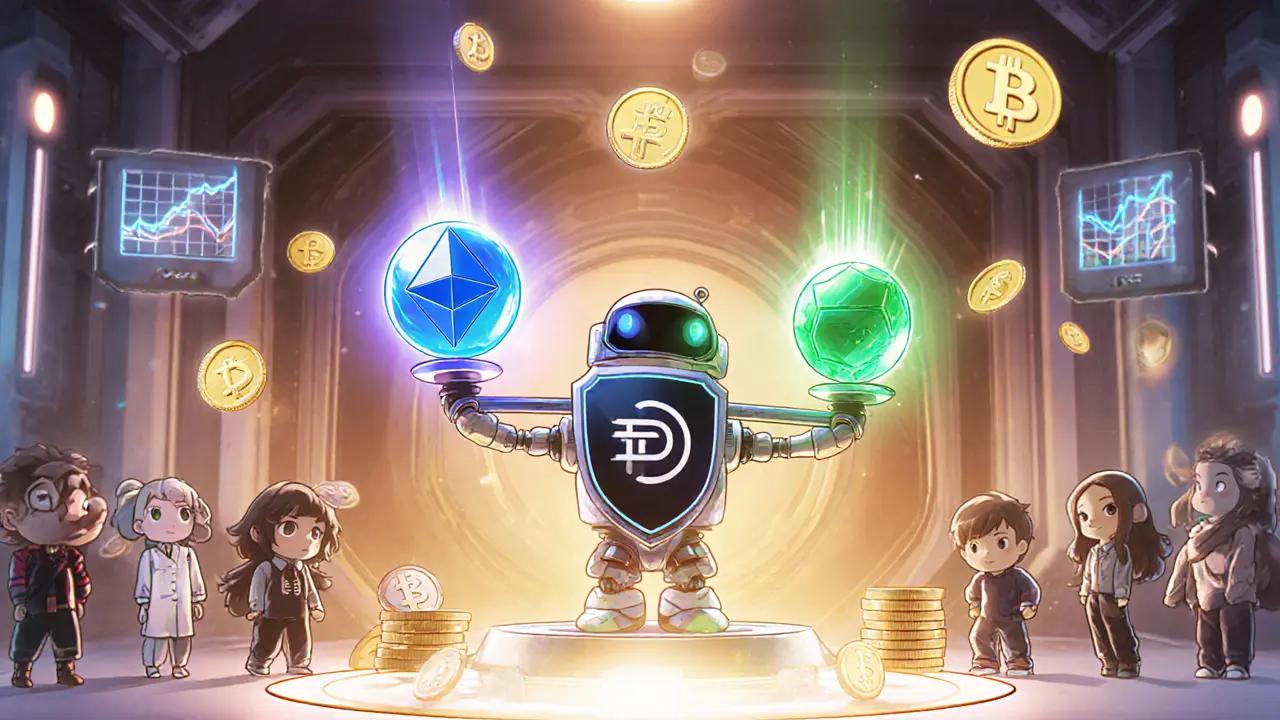Dinero (DINERO) vs DIN Comparison Calculator
A dollar-pegged stablecoin backed by ETH and pxETH. Designed for DeFi users seeking stability and yield generation.
- Price: $0.008108
- 24h Volume: $90,846
- Collateral: ETH + pxETH
A mineable cryptocurrency focused on privacy, speed, and low-cost transactions via proof-of-work.
- Price: $0.00056535
- 24h Volume: $13.77
- Algorithm: Proof-of-Work
| Attribute | DINERO | DIN |
|---|---|---|
| Primary Purpose | Dollar-pegged payment and yield generation | Private, instant payments via proof-of-work |
| Collateral Model | Over-collateralized with ETH + pxETH (plus USDC buffer) | None - token is mined directly |
| Supply | Dynamic - minted/burned to maintain peg | 10.94M total, 100M hard cap |
| Current Price (Oct 2025) | $0.008108 | $0.00056535 |
| 24-h Volume | $90,846 | $13.77 |
| Core Ecosystem | Redacted Cartel, Dinero.xyz, Btrfly | Independent mining community |
DINERO is ideal for DeFi users seeking a stable, yield-generating asset with strong collateral backing. DIN, on the other hand, caters to privacy-focused users and hobbyist miners who prefer anonymity over stability. Both tokens operate under the Dinero ecosystem but serve distinct purposes.
Quick Facts
- DINERO is a stablecoin backed by Ethereum (ETH) and pxETH, created by Redacted Cartel.
- DIN is a separate, mineable token that focuses on privacy and instant payments.
- The stablecoin pegs to$1, uses over‑collateralization, and earns yield from its reserve assets.
- Both projects live under the broader Dinero ecosystem, which includes yield‑optimizing tools on Dinero.xyz.
- Trading volume for DINERO is higher than DIN, but the token remains unlisted on major exchanges.
When you hear the name Dinero (DINERO) is a dollar‑pegged stablecoin that lives inside the Redacted Cartel DeFi suite, the first question is usually: "What exactly does it do?" The answer isn’t a single line because "Dinero" actually covers a handful of projects that share a brand but serve very different audiences. In this guide we’ll break down the two main tokens-DINERO the stablecoin and DIN the mineable privacy coin-explain how they fit into the larger ecosystem, and give you concrete data you can use to decide whether either one belongs in your wallet.
What Is the DINERO Stablecoin?
The flagship token, DINERO is a stablecoin that keeps a 1:1 peg to the US dollar by locking up Ethereum (ETH) and pxETH as collateral. Launched by the developer collective known as Redacted Cartel (a group that builds DeFi infrastructure and governance tools), DINERO aims to be more than just a cash‑like token. It generates yield by letting the pooled ETH earn interest while the paired pxETH-short for "Pirex Ethereum"-acts as a high‑yielding liquid‑restaking asset.
Why split the reserve between ETH and pxETH? The protocol’s designers opted for a 50/50 split to balance two goals:
- Security: ETH is the most liquid and widely trusted asset on the Ethereum network, giving DINERO a solid floor.
- Yield: pxETH can be staked in DeFi protocols that pay higher returns than plain ETH staking, boosting the overall earnings of the reserve.
To protect the peg during price spikes, the system also holds a small amount of USDC as a secondary collateral layer. This extra cushion helps absorb upward pressure on the dollar value without requiring a massive sell‑off of ETH or pxETH.
How Does DINERO Stay Pegged?
Every DINERO token is minted when a user deposits the required amount of ETH and pxETH into the smart‑contract vault. The contract then records the total collateral value and creates an equal number of DINERO tokens. If the combined market value of the collateral dips below the $1 threshold, the protocol automatically triggers a liquidation process: the vault sells a portion of the assets to bring the ratio back up. Because the vault holds two assets, a dip in ETH can often be offset by a rise in pxETH, and vice‑versa, making the peg more resilient than single‑collateral stablecoins.
Yield generation works in parallel. While the assets sit in the vault, they are delegated to DeFi strategies that earn interest-think lending platforms, liquid‑restaking farms, or curve‑style pools. The earned yield is funneled back into the vault, increasing the overall collateral base and, by extension, the stability of the token.
The Mining Counterpart: DIN Token
Running a completely different set of goals is DIN is a mineable cryptocurrency that focuses on privacy, speed, and low‑cost transactions. DIN’s project page (dinerocoin.org) describes it as "A New Digital Currency, Based On Bitcoin And Dash, That Enables Anonymous, Instant Payments To Anyone, Anywhere In The World." In practice, DIN uses a proof‑of‑work algorithm similar to Bitcoin but with a lower difficulty curve, allowing ordinary users to mine with modest hardware.
Key statistics as of October2025:
- Current price: $0.00056535 USD
- 24‑hour price change: +89.39%
- 24‑hour trading volume: $13.77 (very low)
- Total supply: 10.94million DIN
- Circulating supply: 8.94million DIN
- Maximum cap: 100million DIN
The token’s market depth is shallow, which means a single large order can swing the price dramatically. That volatility, combined with the focus on anonymity, puts DIN in direct competition with established privacy coins like Monero and Zcash, making it a niche choice for users who value concealment over mainstream adoption.
Comparing DINERO Stablecoin vs. DIN Mining Token
| Attribute | DINERO (Stablecoin) | DIN (Mining Token) |
|---|---|---|
| Primary purpose | Dollar‑pegged payment and yield generation | Private, instant payments via proof‑of‑work |
| Collateral model | Over‑collateralized with ETH + pxETH (plus USDC buffer) | None - token is mined directly |
| Supply | Dynamic - minted/burned to maintain peg | 10.94M total, 100M hard cap |
| Current price (Oct2025) | $0.008108 | $0.00056535 |
| 24‑h volume | $90,846 | $13.77 |
| Core ecosystem | Redacted Cartel, Dinero.xyz, Btrfly | Independent mining community |
In short, DINERO is built for institutional‑grade DeFi users who need a reliable dollar anchor and want to earn extra yield on the reserve assets. DIN, on the other hand, appeals to hobbyist miners and privacy‑focused users who are willing to trade stability for anonymity.

Where Does Dinero.xyz Fit In?
The Dinero.xyz is a suite of DeFi products that scale yield for chains, users, and institutions. Its flagship offering is the liquid‑restaking protocol for pxETH, which is promoted as "DeFi's highest yielding Ethereum liquid restaking solution." By allowing users to stake ETH, receive pxETH, and then deploy that pxETH into high‑yield farms, Dinero.xyz creates a feedback loop that feeds back into the DINERO stablecoin's reserve, increasing overall earnings.
The platform also plans to launch meta‑transactions that let users pay gas fees with tokens other than ETH. Imagine buying a DINERO stablecoin on a DEX without ever holding ETH in your wallet-future updates aim to make that possible, lowering friction for retail participants.
How Do Governance and Related Tokens Influence DINERO?
Redacted Cartel governs the entire ecosystem through a DAO (Decentralized Autonomous Organization). Token holders can vote on reserve ratios, fee structures, and roadmap milestones. One of the DAO’s side‑effects is the Btrfly token (Btrfly is a utility token that rewards participants across the Redacted Cartel network). When DINERO’s reserve performs well, Btrfly’s value often rises because the two assets share liquidity pools and governance incentives. This inter‑dependency means that improvements to DINERO-like adding private transaction capabilities-can indirectly boost Btrfly holders.
Current Market Performance and Risks
As of the latest snapshot (Oct22025), DINERO trades at $0.008108 with a 24‑hour volume of roughly $90K. The token has slipped 2.30% in the past day and 3.62% over the past week, showing a mild bearish trend on weekly charts. Technical indicators (MACD, moving averages) suggest the price could linger below the $0.01 mark until a clear catalyst-like a major exchange listing-appears.
DIN, by contrast, is barely trading ($13.77 volume) despite an 89% daily surge. The low liquidity makes it risky for large holders; a single sell order can wipe out much of the market cap. Moreover, privacy‑focused cryptocurrencies face increasing regulatory scrutiny, especially in jurisdictions that are tightening AML/KYC rules.
Both tokens share a common risk: reliance on the broader Redacted Cartel ecosystem. If the DAO’s governance decisions lead to unfavorable fee structures or if pxETH’s liquid‑restaking model encounters a smart‑contract exploit, DINERO’s peg could be stressed. For DIN, the risk is more classic mining difficulty adjustments and the potential for hash‑rate centralization.
Future Outlook: What to Watch
Redacted Cartel’s roadmap includes three key milestones that could reshape DINERO’s value proposition:
- Meta‑transaction layer: Enables gas‑less swaps using DINERO or Btrfly, lowering entry barriers.
- Private transaction support: Leverages pxETH’s block‑space to hide transaction details, moving DINERO beyond a plain stablecoin.
- Relay infrastructure: A proprietary relay network that could speed up finality and reduce fees.
If these features roll out on schedule, DINERO could attract institutional DeFi funds that need both stability and privacy-an unusual combination in the current market.
For DIN, the primary driver will be community adoption and mining hardware accessibility. Unless the project differentiates itself with a clear privacy advantage or integrates with a larger ecosystem (e.g., being accepted on privacy‑centric marketplaces), it may remain a niche token with modest price swings.
How to Get Started with Dinero Projects
Here’s a quick checklist for anyone wanting to dip a toe into the Dinero universe:
- Set up a wallet: Use Metamask or a hardware wallet that supports Ethereum and ERC‑20 tokens.
- Acquire ETH: You'll need ETH to cover gas fees and to provide collateral for DINERO.
- Mint DINERO: Go to the official Redacted Cartel portal, deposit the required ETH+pxETH ratio, and receive DINERO in your wallet.
- Stake pxETH: If you want to boost yield, stake ETH in the pxETH contract via Dinero.xyz, then feed the pxETH back into the DINERO vault.
- Mine DIN (optional): Download the DIN miner from dinerocoin.org, join a mining pool, and start earning DIN tokens.
- Participate in governance: Acquire Btrfly or DINERO voting power to influence future updates.
Always double‑check contract addresses from the official Github or documentation page to avoid phishing scams. Using reputable explorers like Etherscan can help you verify that the token you receive is the genuine Dinero cryptocurrency and not a look‑alike.
Frequently Asked Questions
Is DINERO truly a stablecoin?
Yes. DINERO maintains a $1 peg by over‑collateralizing with ETH and pxETH, plus a USDC buffer. If the collateral value drops, the smart contract automatically liquidates enough assets to restore the peg.
How does DIN differ from other privacy coins like Monero?
DIN uses a Bitcoin‑style proof‑of‑work algorithm with a focus on low‑cost, fast transactions, but it has far less development activity and a tiny market depth compared to Monero. Its anonymity features are more basic, making it a niche alternative rather than a direct competitor.
Can I earn yield with DINERO without staking?
Yield comes from the underlying ETH/pxETH assets that the DINERO vault allocates to DeFi strategies. As a holder, you automatically benefit from any earnings the vault generates-no extra staking required.
Where can I buy DINERO or DIN?
DINERO is available on several decentralized exchanges (Uniswap, SushiSwap) and a few niche centralized platforms. DIN has limited listings-mostly on small DEXs-so liquidity can be thin. Always verify the token contract address before trading.
What is the roadmap for meta‑transactions?
Redacted Cartel plans to launch a meta‑transaction layer by Q22026. This will let users pay gas fees with DINERO or Btrfly, making transactions cheaper and more user‑friendly, especially for newcomers.
Whether you’re after a stablecoin that earns a little extra on the side or a privacy‑first mining token, the Dinero ecosystem offers options for both camps. Keep an eye on the DAO votes and upcoming feature releases-those can swing the value and utility of each token dramatically. Happy exploring!




Jeff Carson
December 30, 2024 AT 01:51DINERO looks solid for yield farming, nice work! 😊
Anne Zaya
December 30, 2024 AT 02:51The stablecoin side seems decent, especially with ETH collateral. The mining token, though, feels like a niche play.
Emma Szabo
December 30, 2024 AT 03:58Wow, the dual‑token design is like a Swiss‑army knife for crypto enthusiasts!
On one hand you get a dollar‑peg that can be used in DeFi protocols, and on the other a privacy‑focused miner’s coin. It’s a clever way to cater to both yield‑hunters and privacy lovers. I can already see arbitrage opportunities between the two.
Fiona Lam
December 30, 2024 AT 04:31Honestly, the DIN token is just junk-proof‑of‑work junk. Who needs another low‑value miner when Bitcoin already dominates?
alex demaisip
December 30, 2024 AT 05:21From a technical standpoint, the over‑collateralization model of DINERO adheres to the rigorous standards of collateral‑backed stablecoins. The dynamic mint‑burn mechanism ensures price stability, leveraging ETH and pxETH as primary assets. Conversely, DIN lacks any intrinsic value backing, rendering it speculative at best.
Elmer Detres
December 30, 2024 AT 06:03Let’s keep it real: DINERO can boost your APY, while DIN just burns electricity for fun. 🚀
Tony Young
December 30, 2024 AT 07:01Picture this: you stake DINERO, watch it grow, and the market whispers your success! 😎
Meanwhile, DIN miners hide in the shadows, unnoticed.
Fiona Padrutt
December 30, 2024 AT 07:51Our nation should back stablecoins like DINERO-American innovation leading the future of finance.
Briana Holtsnider
December 30, 2024 AT 08:16This whole token split is just a marketing gimmick. Nobody’s buying it.
Corrie Moxon
December 30, 2024 AT 09:23Even if it’s niche, there’s room for both stable and private tokens. Let’s give users options.
OLAOLUWAPO SANDA
December 30, 2024 AT 10:13Dunno why anyone would trust a coin that depends on ETH. Simple math: risk.
Alex Yepes
December 30, 2024 AT 11:36In examining the architecture of the Dinero ecosystem, one observes a bifurcated strategy designed to address divergent market demands. The DINERO stablecoin, anchored by an over‑collateralized reserve of ETH and pxETH, employs a dynamic mint‑and‑burn protocol that rigorously maintains the one‑to‑one US‑dollar peg. This mechanism not only stabilizes price volatility but also furnishes a reliable yield‑bearing instrument for institutional participants seeking low‑risk exposure within decentralized finance. Conversely, the DIN mining token embraces a proof‑of‑work consensus, prioritizing privacy, transaction speed, and negligible fees, thereby appealing to hobbyist miners and privacy advocates. Although the mining facet introduces an element of supply elasticity, its hard cap of 100 million tokens imposes a finite ceiling that may engender scarcity‑driven valuation over time. The dual‑token model, therefore, creates a symbiotic relationship: DINERO supplies liquidity and stability for DeFi protocols, while DIN offers a parallel avenue for decentralized, censorship‑resistant transactions. Such a design reflects an astute recognition of the heterogeneity inherent within the broader crypto community. Moreover, the integration of collateralized assets mitigates systemic risk, aligning the stablecoin with regulatory expectations pertaining to asset‑backed tokens. It is prudent, however, to monitor the health of the underlying collateral pool, especially given market fluctuations in ETH valuation. The ecosystem’s ancillary components-Redacted Cartel, Dinero.xyz, and Btrfly-further augment utility by providing governance, staking, and ancillary DeFi services. In sum, investors should evaluate their risk tolerance: risk‑averse participants may gravitate toward DINERO for its predictable yield, whereas those inclined toward speculative, privacy‑first ventures might allocate capital to DIN. Both pathways possess distinct merit, contingent on individual strategic objectives and market conditions.
Sumedha Nag
December 30, 2024 AT 12:10Honestly, that long‑winded essay feels like a textbook. Real world users just want simple returns.
Holly Harrar
December 30, 2024 AT 13:08Grab the DINERO token if u want stable deFi yields. The DIN token is cool 4 privacy lovers.
Vijay Kumar
December 30, 2024 AT 13:58Let’s keep the momentum! If you’re new, start small with DINERO and watch compounding work its magic.
Don’t forget to explore mining if you’re into that hustle.
Edgardo Rodriguez
December 30, 2024 AT 14:23One might ponder: does the coexistence of a stablecoin and a miner’s token not epitomize the dialectic of security versus anonymity?; Indeed, the ecosystem invites a philosophical dialogue about value creation;.
mudassir khan
December 30, 2024 AT 15:13This project is over‑engineered; the tokenomics lack transparency, and the whitepaper is riddled with buzzwords.
Bianca Giagante
December 30, 2024 AT 16:11Let’s try to keep the discussion constructive; everyone has a perspective worth hearing;.
Andrew Else
December 30, 2024 AT 17:18Wow, another crypto experiment. Maybe next year will finally be the one that sticks.